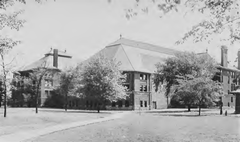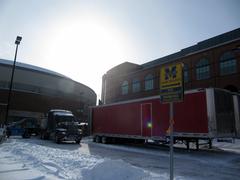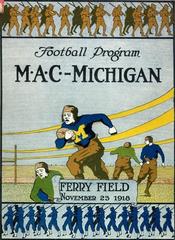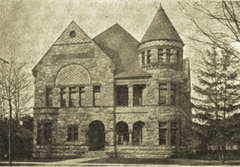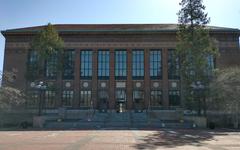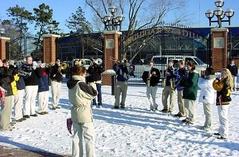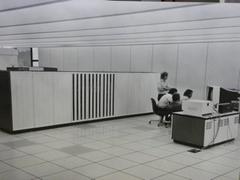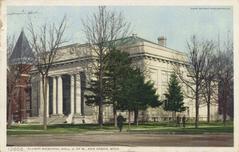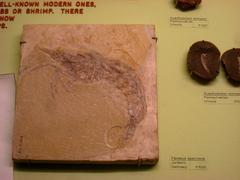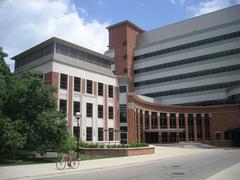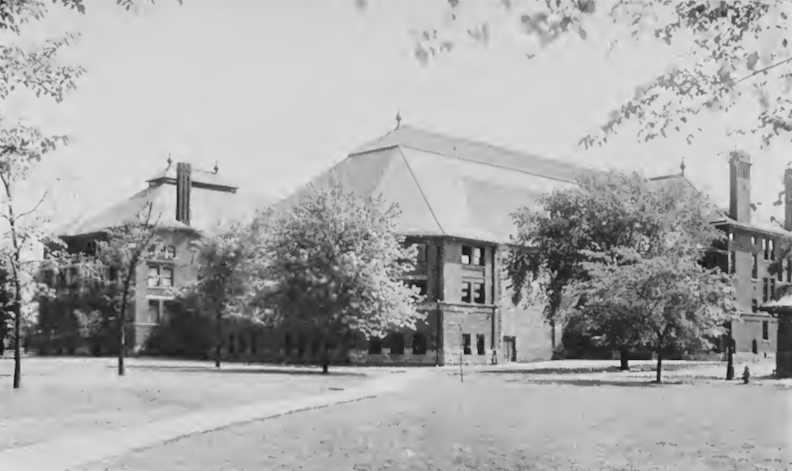
Waterman Gymnasium: Visiting Hours, Tickets, and Historical Significance in Ann Arbor
Date: 15/06/2025
Introduction
Waterman Gymnasium, once a prominent fixture on the University of Michigan’s Central Campus in Ann Arbor, played a vital role in shaping the university’s commitment to physical education, student wellness, and campus community from its opening in 1894 until its demolition in 1977. Though the building no longer stands, its legacy endures through archival collections, historical exhibits, and the memories of alumni. This comprehensive guide explores Waterman Gymnasium’s rich history, architectural and cultural significance, and offers practical information for those seeking to engage with its memory and the wider heritage of Ann Arbor’s historic sites. (Bentley Historical Library, Michigan in the World, University of Michigan Heritage Project, Ann Arbor District Library)
Contents
- Origins and Construction of Waterman Gymnasium
- Role in University Life and Athletics
- Architectural Features and Innovations
- Social and Cultural Significance
- Decline, Demolition, and Preservation Legacy
- Visiting the Waterman Gymnasium Site Today
- Nearby Ann Arbor Historical Attractions
- Visitor Information: Hours, Tickets, Accessibility, Dining, and Accommodation
- Frequently Asked Questions (FAQ)
- Conclusion
- References
Origins and Construction of Waterman Gymnasium
A Response to the Demand for Physical Education
Waterman Gymnasium emerged during a period of rapid change in higher education, as universities nationwide began prioritizing student wellness and physical education. Named for Dr. William P. Waterman, a physician and university regent, the gymnasium was made possible through significant fundraising, including a $20,000 donation from Joshua W. Waterman and contributions from students and the university Regents. Construction began in 1893, with the gymnasium opening in 1894 (Bentley Historical Library).
Design and Innovation
Detroit architects Spier & Rohns designed the building in the Romanesque Revival style, using red brick and stone trim. Its vast, column-free interior was made possible by innovative steel trusses, and at 150 by 80 feet, Waterman was among the largest university gymnasiums of its era. The initial cost was approximately $50,000, a substantial investment reflecting the university’s forward-thinking approach (University of Michigan Heritage Project).
Role in University Life and Athletics
Central Hub for Student Activity
Waterman Gymnasium quickly became the heart of physical education and student life for men at the University of Michigan. It featured a large open floor for gymnastics, basketball, and calisthenics, an elevated running track, locker rooms, and faculty offices. Barbour Gymnasium, built in 1896, provided similar facilities for women (Michigan Today).
Athletic Achievements
The gymnasium was the site of Michigan’s first intercollegiate basketball game in 1909 and also hosted wrestling, fencing, gymnastics, and intramural competitions. It played a crucial role in developing the university’s athletic programs and fostering school spirit (UMich Athletics).
Architectural Features and Innovations
Structural Advances
Waterman’s steel truss system allowed for an unobstructed, flexible interior, ideal for a variety of athletic activities. The hard maple gym floor was both durable and resilient, while large windows and skylights provided ample natural light (Ann Arbor District Library).
Health and Hygiene
Ventilation systems, showers, and modern locker rooms reflected contemporary priorities in health and student well-being. Over the years, renovations introduced updated equipment and facilities, ensuring the gymnasium remained relevant until the mid-20th century.
Social and Cultural Significance
Community and Tradition
Beyond athletics, Waterman was a vibrant community hub, hosting registration events, dances like the “J-Hop,” academic banquets, lectures, and even military training during the World Wars (Alumni Gateway). Its adaptability fostered a strong sense of campus tradition and unity.
Pioneering Gender Equity
Initially exclusive to men, the gymnasium’s proximity to Barbour Gymnasium and the subsequent appointment of Dr. Eliza Mosher as Dean of Women signaled changing attitudes toward gender inclusion on campus (UMich Campus Histories).
Decline, Demolition, and Preservation Legacy
Changing Needs and Deferred Maintenance
By the 1970s, Waterman Gymnasium’s infrastructure could not meet the demands of a growing university. Newer athletic facilities rendered it obsolete, and deferred maintenance made restoration unfeasible (University of Michigan Bentley Historical Library). The university’s exemption from local historic preservation laws further limited efforts to save the building (themich.org).
Demolition and Community Response
Waterman and Barbour Gymnasiums were demolished in 1977 to enable the Chemistry Building’s expansion, spurring debate over the balance between modernization and historic preservation. The loss of Waterman influenced later successful preservation campaigns, such as that for the Detroit Observatory (themich.org).
Visiting the Waterman Gymnasium Site Today
Location and Current Use
Waterman Gymnasium was located at North University Avenue and Ingalls Street, adjacent to Hill Auditorium and the Diag. The Chemistry Building now occupies its former site (University of Michigan Campus Map).
What Remains
While no physical traces of Waterman Gymnasium remain, visitors can explore the site and surrounding campus. Historical markers and plaques in the area reference the gymnasium’s significance. The Bentley Historical Library and Ann Arbor District Library offer extensive digital archives, photographs, and blueprints for those seeking a deeper connection to the past.
Campus Tours
Guided and self-guided campus tours are available year-round and often include stories about Waterman Gymnasium’s legacy (University of Michigan Tours).
Nearby Ann Arbor Historical Attractions
- Hill Auditorium: Iconic concert venue adjacent to the Waterman site (Hill Auditorium)
- The Diag: Central gathering space reflecting campus life (Two Sisters Abroad)
- Kelsey Museum of Archaeology: Free admission, extensive artifact collection (Kelsey Museum)
- University of Michigan Museum of Art (UMMA): International art collections (UMMA)
- Detroit Observatory: Example of successful campus preservation (themich.org)
Visitor Information
Hours and Tickets
There are no specific visiting hours or ticket requirements for the Waterman Gymnasium site, as it is now part of Central Campus and the Chemistry Building. The campus is generally open to the public year-round; check building-specific hours if you wish to enter nearby facilities (University of Michigan Campus Map).
Accessibility
The University of Michigan Central Campus and the Chemistry Building are fully accessible, with paved walkways, ramps, and accessible entrances (U-M Accessibility).
Dining and Accommodation
- Dining: Options nearby include Angelo’s, Aventura, and Blank Slate Creamery (Two Sisters Abroad).
- Lodging: Graduate Ann Arbor, Bell Tower Hotel, and numerous Airbnb rentals offer convenient accommodations (Graduate Ann Arbor, Bell Tower Hotel).
Special Events
Central Campus hosts events such as the Ann Arbor Summer Festival and regular university sporting events (Ann Arbor Summer Festival, Busy Tourist). Check the University of Michigan events calendar for current listings.
Frequently Asked Questions (FAQ)
Can I visit Waterman Gymnasium?
Waterman Gymnasium was demolished in 1977. However, you can visit the site now occupied by the Chemistry Building and learn about its history through campus markers, tours, and archival resources.
Are there guided tours that include Waterman Gymnasium history?
Yes, guided and self-guided campus tours often include historical information about Waterman Gymnasium (University of Michigan Tours).
Where can I find photographs or blueprints of Waterman Gymnasium?
The Bentley Historical Library and Ann Arbor District Library have extensive digital archives.
Is there an entry fee or ticket required?
No; the campus grounds and historic markers are freely accessible to the public.
What replaced Waterman Gymnasium?
The Chemistry Building now stands on the original site; other athletic functions moved to newer facilities such as Yost Field House and the Intramural Sports Building.
Conclusion
Waterman Gymnasium’s legacy represents the University of Michigan’s pioneering approach to student wellness, athletics, and inclusion. While the building is physically gone, its influence persists in university traditions, historic archives, and the cultural memory of Ann Arbor. Visitors can engage with this legacy through campus tours, archival research, and by exploring related historic sites. Whether you’re a history enthusiast or a casual visitor, the story of Waterman Gymnasium adds depth and context to any exploration of the University of Michigan and the city of Ann Arbor.
For a deeper dive, download the Audiala mobile app for self-guided campus tours and additional content about Ann Arbor’s heritage. Check out our other articles on university history and historic landmarks to enrich your visit.
References
- Bentley Historical Library – Waterman Gymnasium
- Michigan in the World – Waterman Gymnasium
- The Mich – A Hideaway In Plain Sight
- University of Michigan Campus Map
- University of Michigan Heritage Project
- Ann Arbor District Library Digital Collections
- University of Michigan Tours
Image Suggestions:
- Photo of the Chemistry Building at the former Waterman Gymnasium site (alt: “Chemistry Building at University of Michigan, former site of Waterman Gymnasium”)
- Panoramic view of the Diag and Central Campus (alt: “University of Michigan Diag and Central Campus historic landmarks”)
- Historic plaque about Waterman Gymnasium (alt: “Historical marker about Waterman Gymnasium at University of Michigan”)
- Hill Auditorium exterior (alt: “Hill Auditorium adjacent to Waterman Gymnasium site”)
(Ensure all images are optimized with relevant alt tags such as “Waterman Gymnasium history,” “University of Michigan historic sites,” and “Ann Arbor historical landmarks.”)
